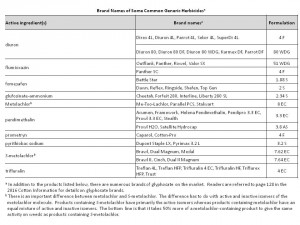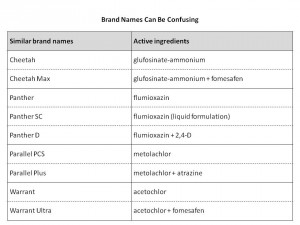New or Almost New Herbicides for 2016 (York)
go.ncsu.edu/readext?408392
en Español / em Português
El inglés es el idioma de control de esta página. En la medida en que haya algún conflicto entre la traducción al inglés y la traducción, el inglés prevalece.
Al hacer clic en el enlace de traducción se activa un servicio de traducción gratuito para convertir la página al español. Al igual que con cualquier traducción por Internet, la conversión no es sensible al contexto y puede que no traduzca el texto en su significado original. NC State Extension no garantiza la exactitud del texto traducido. Por favor, tenga en cuenta que algunas aplicaciones y/o servicios pueden no funcionar como se espera cuando se traducen.
Português
Inglês é o idioma de controle desta página. Na medida que haja algum conflito entre o texto original em Inglês e a tradução, o Inglês prevalece.
Ao clicar no link de tradução, um serviço gratuito de tradução será ativado para converter a página para o Português. Como em qualquer tradução pela internet, a conversão não é sensivel ao contexto e pode não ocorrer a tradução para o significado orginal. O serviço de Extensão da Carolina do Norte (NC State Extension) não garante a exatidão do texto traduzido. Por favor, observe que algumas funções ou serviços podem não funcionar como esperado após a tradução.
English
English is the controlling language of this page. To the extent there is any conflict between the English text and the translation, English controls.
Clicking on the translation link activates a free translation service to convert the page to Spanish. As with any Internet translation, the conversion is not context-sensitive and may not translate the text to its original meaning. NC State Extension does not guarantee the accuracy of the translated text. Please note that some applications and/or services may not function as expected when translated.
Collapse ▲Brake F16 recently received full registration for use on cotton. It is a mixture of fluridone and fomesafen (fomesafen is the active ingredient in Reflex). Brake F16 was available under a Section 18 Exemption in 2015, and Brake F2 (different ratio of active ingredients) was available under Section 18 in 2014. At the typical use rate of 1 pt per acre, Brake F16 gives 0.15 lb ai of fluridone and 0.1875 lb ai of fomesafen (equivalent to 12 oz of Reflex). The current label claims control only of pigweed species, but Brake F16 has pretty good activity on annual grasses and most small-seeded broadleaf weeds.
Most North Carolina research with Brake F16 has focused on Palmer amaranth. Control has been as good as or sometimes a little better than with our commonly used preemergence combinations. Cotton tolerance has been good. Brake F16 is not a stand-alone product. One needs to follow Brake with a normal, timely postemergence program.
Fierce is a premix of flumioxazin (the active ingredient in Valor) plus pyroxasulfone (the active ingredient in Zidua). Applied at 3 oz/acre, Fierce is equivalent to 2 oz of Valor plus 1.5 oz Zidua. It is only for directed layby application. Cotton should be at least 16 inches tall, and the spray should contact no more than the bottom 2 inches of the crop. Fierce can be mixed with glyphosate, glufosinate, or MSMA. Fierce will give good burndown of emerged weeds and excellent residual control of Palmer amaranth.
Outlook has a supplemental label for postemergence overtop application to cotton from the first true leaf stage until mid-bloom. Outlook is similar in chemistry and weed control spectrum to Dual Magnum or Warrant. The supplemental label is a little unclear on use rates, but 12 fl oz/acre would be the target rate for most Coastal Plain soils. In limited North Carolina research, cotton tolerance of Outlook is similar to that for Dual Magnum or Warrant.
Warrant Ultra is a premix of encapsulated acetochlor (the active ingredient in Warrant) and fomesafen (the active ingredient in Reflex). A typical use rate of Warrant Ultra is 3 pt/acre, which would be equivalent to 2.8 pt of Warrant plus 15 oz of Reflex.
Do not confuse Warrant and Warrant Ultra. Warrant can be applied preemergence, postemergence overtop, or postemergence directed. Warrant Ultra is for preemergence or directed layby application only. Warrant Ultra applied postemergence overtop will severely injure or kill cotton.
Zidua can be directed to cotton from the 5-leaf stage to initial bloom. It will not control emerged weeds but it can be added to other directed herbicides to give residual control. Zidua has good residual activity on pigweed species and annual grasses. Do not apply Zidua overtop cotton; it is too injurious.
Generic Brands
Most of our cotton herbicides are old enough that the original patents have expired and generic brands are now available. With a few exceptions, we have found that generic brands basically perform as well as the name brands. However, concentrations of active ingredients may vary between the name brands and generics, hence rate adjustments may be necessary. One area where name brands and generics can differ significantly is with S-metolachlor and metolachlor. See the comments in the below table Brand Names of Some Common Generic Herbicides.
Brand Names Can be Similar for Vastly Different Products; Exercise Caution
There are several products available with brand names that are similar but the contents are vastly different. Growers are urged to exercise caution to make sure what they put in the spray tank is actually what they intended to put in there. The wrong product can lead to a very bad day. See the second table below, Brand Names Can Be Confusing.




